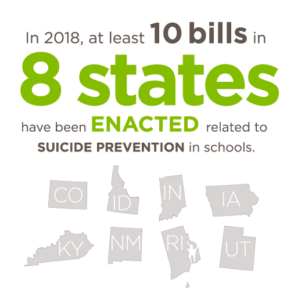Too often, we hear stories of young people taking their own lives and we find ourselves asking what could have been done to prevent these tragedies. Suicide is a public health crisis in this country, and youth suicide rates are striking and concerning: It is the second leading cause of death among youth ages 10-18 and according to the CDC, suicide rates have increased significantly for all age groups across most states between 1999-2016.
 This National Suicide Prevention Awareness Month, we are looking at how states are responding to this crisis — specifically with support for schools and classrooms, which are primary avenues for prevention and early intervention. For example, at least 27 states have mandated suicide prevention training for school personnel; at least 15 states encourage training; and 12 states require school suicide prevention, intervention and postvention policies or suicide prevention programming statewide, according to a recent report by the American Foundation for Suicide Prevention.
This National Suicide Prevention Awareness Month, we are looking at how states are responding to this crisis — specifically with support for schools and classrooms, which are primary avenues for prevention and early intervention. For example, at least 27 states have mandated suicide prevention training for school personnel; at least 15 states encourage training; and 12 states require school suicide prevention, intervention and postvention policies or suicide prevention programming statewide, according to a recent report by the American Foundation for Suicide Prevention.
We also track recent state legislation related to this topic and so far in 2018, at least 10 bills have been enacted related to suicide prevention in schools. They are:
Training for School Personnel:
- Colorado SB 272 creates a grant program to provide training on crisis and suicide prevention for teachers and staff at public schools. This program is run by the state department of public health and environment in collaboration with the office of suicide prevention and the school safety resource center.
- Iowa SF 2113 requires annual training on suicide prevention and postvention, identification of adverse childhood experiences and strategies to mitigate toxic stress for all school personnel who have regular contact with K-12 students.
- Idaho H 634 requires public school personnel to have training in suicide awareness and prevention. The state board of education must develop a list of training materials and the department of education is charged with creating a model policy on suicide prevention for districts to use as a guide for crafting their own policies.
- Indiana SB 230 requires teachers and other school employees to receive at least two hours of research-based youth suicide awareness and prevention training from a program that is 1) demonstrated to be an effective or promising program and 2) recommended by the Indiana Suicide Prevention Network Advisory Council.
- Kentucky HB 30 requires high school and middle school principals, guidance counselors and teachers to have a minimum of one hour of suicide prevention training.
- Utah HB 46 requires a licensed school employee to complete a minimum of two hours of professional development training on youth suicide prevention every three years.
Suicide Prevention Programs and Curricula:
- Rhode Island HB 7987 and SB 2182 direct the department of elementary and secondary education to incorporate substance abuse and suicide prevention into health education curricula using evidence-based, appropriate practices.
- Utah HB 370 expands the scope of suicide prevention programs in schools and increases funding available for the implementation of school-based suicide prevention programs.
Study Committees:
- New Mexico SM 8 requests that the public education department and the legislative education study committee evaluate potential solutions to decrease the rates of suicide by firearms and gun violence in schools.
Until the trend begins to reverse, it is important to stay informed on what we can all do to prevent these tragedies. The National Alliance on Mental Illness provides several helpful resources on knowing the warning signs, preventing suicide and being prepared for a crisis. If you or someone you know are in a crisis, call the National Suicide Hotline at 1-800-273 TALK (8255).










